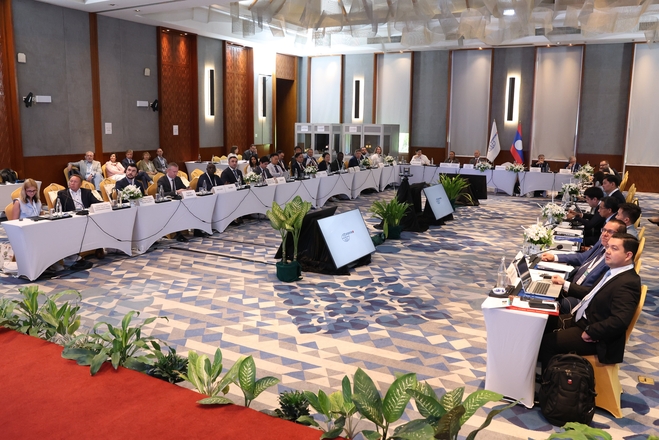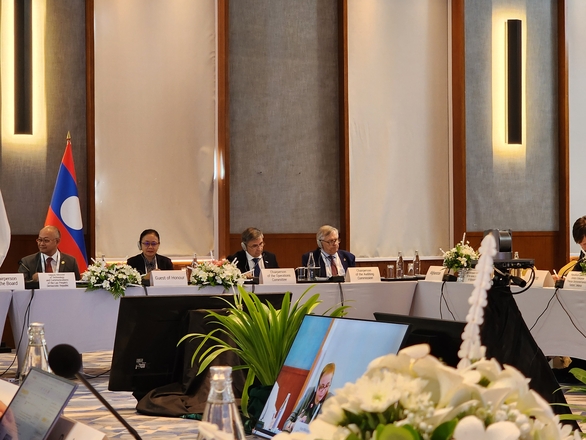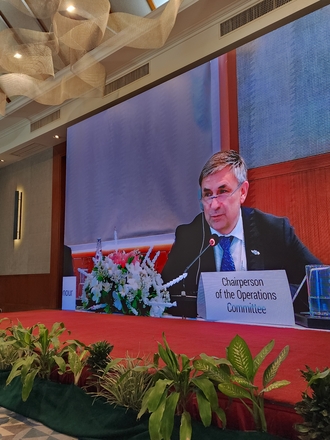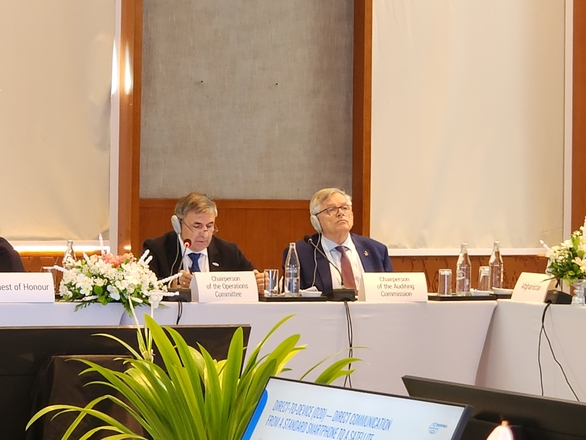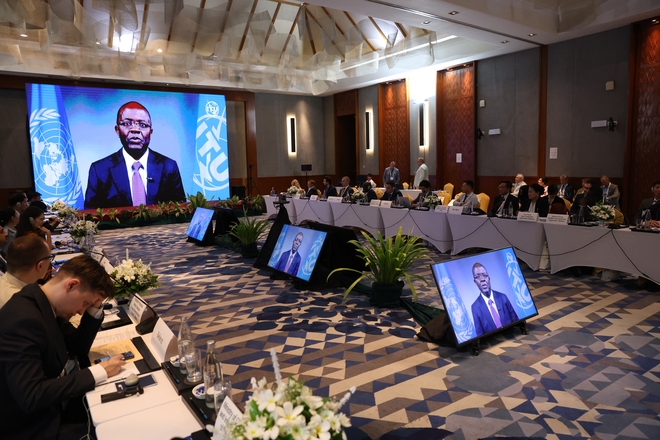At the Nexus of Two Worlds: How the Trend of Combining Mobile and Satellite Communications is Developing, discussed Deputy Director General of RSCC Evgeny Buydinov at the Intersputnik Session
The idea of providing satellite connectivity to 8.5 billion standard mobile devices worldwide is becoming increasingly viable, but is associated with serious challenges. This was reported by Deputy Director General of RSCC, Chairman of the Operations Committee of the Intersputnik International Organization of Space Communications Evgeny Buydinov at the joint 53rd session of the Board and 28th session of the Operations Committee. The event took place on May 22 in Luang Prabang, Laos. The results of the vote on the candidacy for the post of Director General of the IOSC were also announced during the event. Ksenia Drozdova, who held this post until now, was re-elected for the next four years.
"Currently, those who plan to provide D2D (Direct-to-Device) services are divided into two sides. The first includes companies such as Apple, Iridium and Viasat, using the mobile satellite service (MSS) spectrum. The second includes SpaceX and AST, which are following the path of using the spectrum intended for cellular networks," noted Evgeny Buydinov at the first plenary session.
Both options have their pros and cons. Thus, MSS bands have the advantages of global operation without interference, but are still limited, do not provide high bandwidth and require modification of smartphones. The second approach, in turn, has two strong arguments "for":
- significantly larger bandwidth;
- a huge number of consumer devices already operating in these bands.
However, this path will not be without problems: mobile operators have long been operating in the spectrum, which the satellite can interfere with, and international regulations currently do not allow the transmission of a signal from space in these bands. Despite this, the players of the second ''camp'' continue to implement their low-orbit projects with deviations from the current rules, since, in their opinion, it is technologically possible to eliminate interference in a limited area. For this purpose, for example, the US adopted an internal regulatory framework to ensure ''supplemental coverage from space'' (SCS). The standards common to all industry participants are determined by the International Telecommunication Union (ITU), so the industry expects changes in the rules at the upcoming conference of the organization in 2027.
As the Chairman of the Operations Committee of the Intersputnik IOSC added, in terms of subscriber devices, there are also two possible ways to deploy D2D systems.
- Developing customized chipsets to support frequencies of the existing spectrum.
This is what Apple does with Qualcomm with the help of Globalstar, Huawei and, until recently, Iridium. The key advantage is the lack of need for additional permits from local regulators. The main disadvantage is the actual limitation of the market to the premium segment of smartphones.
- Use of standard mobile devices for 3G/4G networks, subject to ensuring the interfacing of the satellite system with the 5G core.
In this case, the market remains mass, but permits from national authorities are required to sublease frequencies of partner cellular companies. SpaceX (in cooperation with T-Mobile USA), as well as AST SpaceMobile (together with AT&T) and Lynk Global are following this path.
"Whichever method proves more effective in the long term, the integration of terrestrial and space technologies can become one of the most important events for both segments in their entire history and open up a whole world of new opportunities for everyone," Evgeny Buydinov is sure. He added that businesses around the world recognize the value of this process and contribute to its development.
For example, in 2024, the creation of an association was initiated to unite the two “worlds” — MSSA (Mobile Satellite Services Association). It will deal with standards for seamless interaction of the infrastructure of cellular and satellite operators, coordination of joint activities, harmonization of tariffs, etc.
In addition, the Deputy Director General of RSCC spoke at a round table devoted to building up potential in the space communications sector. At the round table, Evgeny Buydinov spoke about the specifics of mobile VSAT terminals operating with help of satellites in geostationary orbit. According to him, modern stations are now increasingly meeting users' wishes for smaller weight and dimensions of devices. Thus, portable stations of the FlyAway class (transported in luggage) and ManPack (transported in a backpack package) are suitable for organizing satellite broadband in field conditions. At the same time, they can be deployed by just one person in 10-15 minutes without additional tools. There is a demand for even more compact devices, which are already being developed by Russian enterprises — with a 0.6 m antenna for operation in the Ku-band and with a 0.2 m antenna for the Ka-band. "However, when using small antennas, it is necessary to keep in mind that it will be necessary to compensate for side interference from neighboring spacecraft during reception and not to exceed the permissible level of impact on other devices," summed up Evgeny Buydinov.
The meeting was attended by Anton Yuzhakov, Head of the Department of Strategic Planning and Cooperation with International Organizations of the Department of Mass Communications and International Cooperation of the Ministry of Digital Development of the Russian Federation, Alexey Vdovin, RSCC Director of Business Development — Head of Business Development Service, Ksenia Drozdova, Intersputnik IOSC Director General, Xayluxa Insisiengmay, Deputy Minister of Technology and Communications of the Lao PDR, Chairperson of the Council of the organization, elected for a term until the next session and replacing Deputy Minister of Communications of the Republic of Cuba Ana Julia Marine López, Cosmas Luckyson Zavazava, Director of the Telecommunication Development Bureau of ITU, as well as heads of telecommunications departments, space agencies and telecom enterprises of the participating countries and observers of the Intersputnik IOSC.
